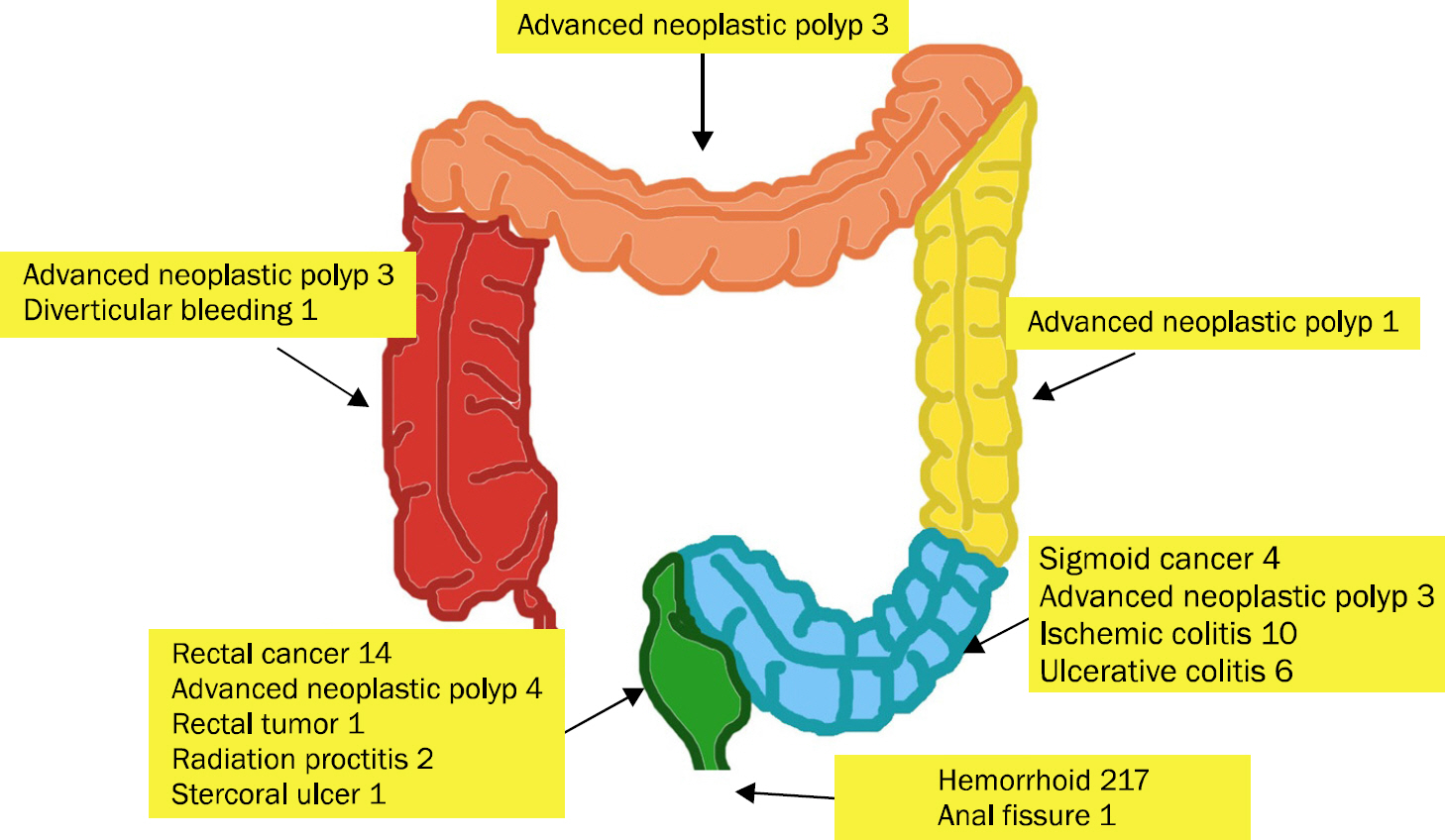Korean J Gastroenterol.
2016 Feb;67(2):87-91. 10.4166/kjg.2016.67.2.87.
Role of Colonoscopy in Patients with Hematochezia
- Affiliations
-
- 1Department of Internal Medicine, College of Medicine, The Catholic University of Korea, Seoul, Korea. hwchoi@catholic.ac.kr
- KMID: 2383546
- DOI: http://doi.org/10.4166/kjg.2016.67.2.87
Abstract
- BACKGROUND/AIMS
Although colonoscopy is not indicated in patients with hematochezia, many surgeons, internists, and physicians are recommending colonoscopy for these patients in Korea. The aim of this study is to evaluate the diagnostic value of colonoscopy for patients with hematochezia.
METHODS
We retrospectively reviewed the data of colonoscopy between January 2010 and December 2010. A total of 321 patients among 3,038 colonoscopies (10.6%) underwent colonoscopy to evaluate the cause of hematochezia. The patients with previous colorectal surgery (2) or polypectomy (5) were excluded. We analyzed endoscopic diagnoses. Advanced neoplastic polyps were defined as adenomas with villous histology or high grade dysplasia, or adenomas more than 10 mm in diameter.
RESULTS
Hemorrhoid was the most common diagnosis (217 cases, 67.6%). Polyps were detected in 93 patients (29.0%), but advanced neoplastic polyps were found in only 14 cases (4.4%). Colorectal cancers were diagnosed in 18 patients (5.6%) including 14 rectal cancers. There was no cancer located above sigmoid-descending junction. Diverticuli were detected in 41 patients (12.8%) but there was only one case of suspected diverticular bleeding. Colitis was diagnosed in 24 patients (7.5%). Other lesions included acute anal fissure, rectal tumor, stercoral ulcer, and radiation proctitis.
CONCLUSIONS
The colonoscopy had little value in patients with hematochezia because the most pathologic lesions were located below sigmoid colon. The first choice of diagnosis in patients with hematochezia is sigmoidoscopy.
MeSH Terms
-
Adolescent
Adult
Aged
Aged, 80 and over
Child
Colitis/complications/diagnosis
Colonic Neoplasms/complications/diagnosis
Colonic Polyps
*Colonoscopy
Colorectal Neoplasms/complications/diagnosis
Female
Gastrointestinal Hemorrhage/diagnosis/*etiology
Hemorrhoids/complications/diagnosis
Humans
Male
Middle Aged
Retrospective Studies
Young Adult
Figure
Reference
-
References
1. Davila RE, Rajan E, Adler DG, et al. Standards of Practice Committee. ASGE Guideline: the role of endoscopy in the patient with lower-GI bleeding. Gastrointest Endosc. 2005; 62:656–660.
Article2. Eisen GM, Dominitz JA, Faigel DO, et al. American Society for Gastrointestinal Endoscopy Standards of Practice Committee. Endoscopic therapy of anorectal disorders. Gastrointest Endosc. 2001; 53:867–870.
Article3. Peytremann-Bridevaux I, Arditi C, Froehlich F, et al. EPAGE II Study Group. Appropriateness of colonoscopy in Europe (EPAGE II). Iron-deficiency anemia and hematochezia. Endoscopy. 2009; 41:227–233.4. Savides TJ, Jensen DM. Gastrointestinal bleeding. Feldman M, Friedman LS, Brandt LJ, editors. Sleisenger and fordtran's gastrointestinal and liver disease: pathophysiology/diagnosis/management. 10th ed.Philadelphia, PA: Saunders/Elsevier;2016. p. 297–335.e210.
Article5. Tong GX, Chai J, Cheng J, et al. Diagnostic value of rectal bleeding in predicting colorectal cancer: a systematic review. Asian Pac J Cancer Prev. 2014; 15:1015–1021.
Article6. Bjerregaard NC, Tøttrup A, Sørensen HT, Laurberg S. Diagnostic value of self-reported symptoms in Danish outpatients referred with symptoms consistent with colorectal cancer. Colorectal Dis. 2007; 9:443–451.
Article7. Nikpour S, Ali Asgari A. Colonoscopic evaluation of minimal rectal bleeding in average-risk patients for colorectal cancer. World J Gastroenterol. 2008; 14:6536–6540.
Article8. Korkis AM, McDougall CJ. Rectal bleeding in patients less than 50 years of age. Dig Dis Sci. 1995; 40:1520–1523.
Article9. Spinzi G, Fante MD, Masci E, et al. SIED Lombardia Working Group, Italy. Lack of colonic neoplastic lesions in patients under 50 yr of age with hematochezia: a multicenter prospective study. Am J Gastroenterol. 2007; 102:2011–2015.
Article10. Wong RF, Khosla R, Moore JH, Kuwada SK. Consider colonoscopy for young patients with hematochezia. J Fam Pract. 2004; 53:879–884.11. Bae T, Ha Y, Kim C, et al. Distribution of the colonoscopic adenoma detection rate according to age: is recommending colonoscopy screening for Koreans over the age of 50 safe? Ann Coloproctol. 2015; 31:46–51.
Article12. Chun JH, Son HJ, Rhee PL, et al. Clinical characteristics of lower gastrointestinal bleeding. Korean J Gastrointest Endosc. 1999; 19:911–917.13. Noer RJ, Robb HJ, Jacobson LF. Circulatory disturbances produced by acute intestinal distention in the living animal. AMA Arch Surg. 1951; 63:520–528.
Article14. Lozano-Maya M, Ponferrada-Díaz A, González-Asanza C, et al. Usefulness of colonoscopy in ischemic colitis. Rev Esp Enferm Dig. 2010; 102:478–483.
Article15. Whitlock EP, Lin JS, Liles E, Beil TL, Fu R. Screening for colorectal cancer: a targeted, updated systematic review for the U.S. Preventive Services Task Force. Ann Intern Med. 2008; 149:638–658.
Article
- Full Text Links
- Actions
-
Cited
- CITED
-
- Close
- Share
- Similar articles
-
- The Role of Colonoscopy in Children with Hematochezia
- Clinical Observation on Patients with Hematochezia
- Clinical assessment and treatment algorithm for lower gastrointestinal bleeding
- A case of sparganosis presenting as hematochezia
- Lower Gastrointestinal Bleeding: Is Urgent Colonoscopy Necessary for All Hematochezia?


